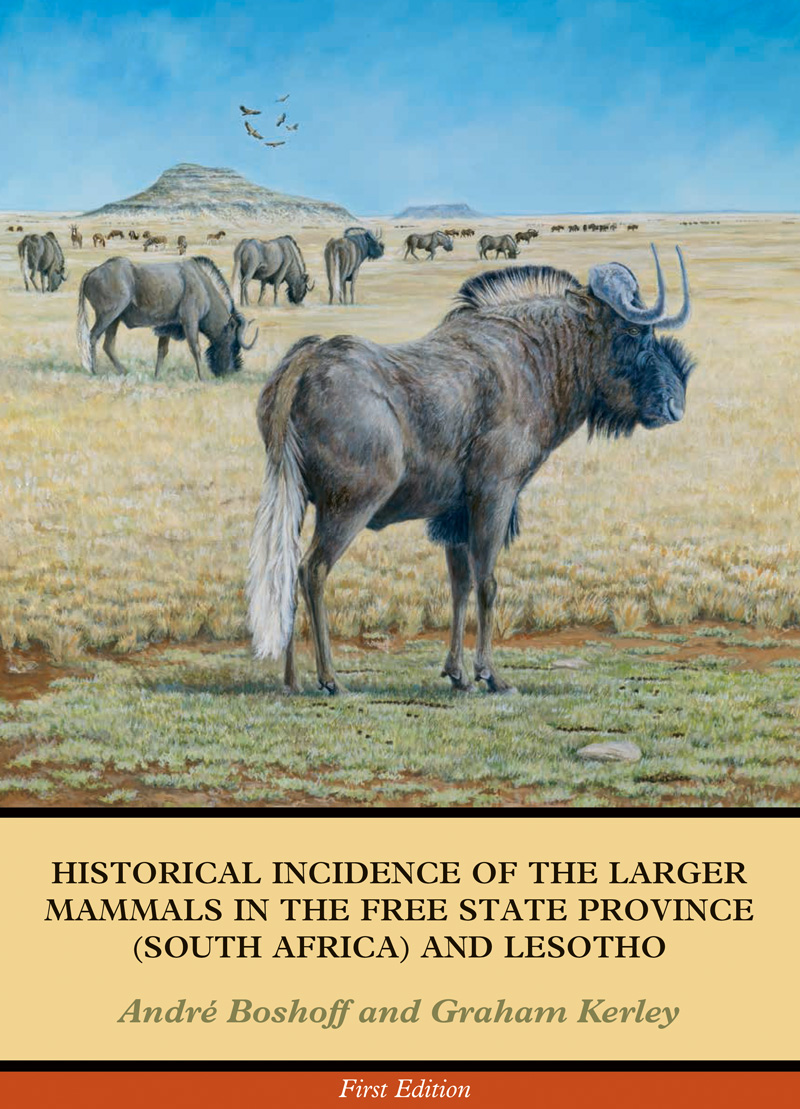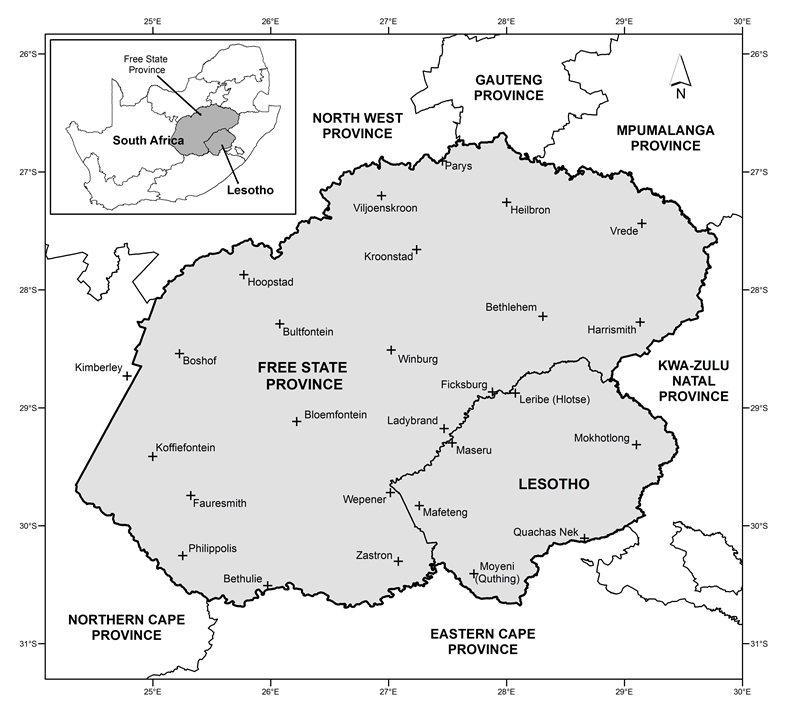Historical incidence of the larger mammals in the Free State Province (South Africa) and Lesotho. 2013. Authors: A Boshoff and G Kerley. Port Elizabeth: Centre for African Conservation Ecology, Nelson Mandela Metropolitan University.

About the book
The Free State Province (one of the Republic of South Africa’s nine provinces) and its south-eastern neighbour, the Kingdom of Lesotho, are characterised by very different topography. The former is dominated by vast plains, with low ridges, hills and mountains in places, and the latter by high mountains and plateaux, dissected by steep-sided river valleys. Prior to a progressive increase in their human populations, which commenced in the 1820s and 1830s, these two territories incorporated a wide range of mammal habitats in a number of almost pristine wetland and terrestrial ecosystems. The latter were dominated by extensive grasslands, with lesser areas of savanna and karroid vegetation. These habitats in turn supported a remarkable array of medium- to large-sized mammals, including the large carnivores (such as the lion, the leopard, the spotted hyaena and the African wild dog) and the very large to smaller herbivores (such as the hippopotamus, the eland, the Burchell's/plains zebra, the black wildebeest, the vaal rhebok and the steenbok).
Until now there has been no single repository for detailed information pertaining to the incidence of these animals, during the early historical period, in the territories in question. Given that many of them were exterminated, or underwent considerable declines in range and numbers, it is crucial to appreciate what occurred there historically, to enable the setting of policy to guide the management of these species, on public and private land, today.
Using a diverse range of sources of information – notably the letters, diaries and journals of early, literate, travellers, explorers, missionaries, military personnel, hunters and agri-pastoralists, supported by selected archaeological and palaeontological records and museum material – this book attempts to estimate the distributions of 54 larger mammal species for the early historical period, i.e. from the 1820s (when the first written records were made) to the 1920s (before large-scale translocations of game animals were undertaken by landowners). All the known records are presented, by decade within each territory, in a series of independent species-specific accounts. For those species for which the quantity and quality of the records is satisfactory, maps depicting the localities of qualifying written, historical records and supporting records are included. For each of the species covered, an ‘Overview’, which interprets the distributional information in the text and on the maps, is presented. Additional information is given in a series of Boxes.
To convey something of the life and times of the early chroniclers, and especially their interactions and experiences with the larger mammals that they encountered, the species texts contain numerous, verbatim, extracts from the original literature sources. In order to provide a human background, a brief summary of the picture – relating to the San, the Khoikhoi, the Bantu-speaking peoples and the European visitors and colonists – during the early historical period is included.
The book also deals with a number of related topics, namely the potential, historical distribution of the larger herbivores in relation to bioregion, some interesting distribution patterns, a review of changes in the status of the larger species since the early 1800s, and observations on movements and migrations of some of the larger ungulates. The very large numbers of plains game (notably the true quagga and the Burchell's/plains zebra, the black wildebeest and the blue wildebeest, the blesbok and the springbok) indicate that the grassland-grazer ecosystem that once existed in the Free State Province and western Lesotho was comparable to, and quite possibly eclipsed, that in similar habitat in East Africa, notably the Serengeti and Masai-Mara grasslands.
The area covered by the book

The area covered by the book incorporates the Free State Province (one of the nine provinces of the Republic of South Africa) and the neighbouring Kingdom of Lesotho.
List of contents
Preface
Chapter 1
Introduction
1. 1 Background
1.1.1 Investigating the historical incidence of the larger mammals in southern Africa
1.1.2 The value of written, historical mammal incidence records
1.1.3 Pitfalls associated with the interpretation of written, historical, mammal incidence records
1. 2 The area covered by the book
1.2.1 The boundaries of the study area
1.2.2 Biophysical features
1.2.3 The human picture around the early historical period
1.3 The approach followed
1.3.1 General
1.3.2 Notes on information sources
1.3.3 Species distribution maps
1.4 Taxonomy and nomenclature
Chapter 2
Historical records: species accounts
Aardvark
Rock hyrax
African elephant
Cape porcupine
Springhare
Chacma baboon
Vervet monkey
Ground pangolin
Aardwolf
Brown hyaena
Spotted hyaena
Hyaena (spec. indet.)
Cheetah
Leopard
Lion
Caracal
African wild cat
Serval
Cats (spec. indet.)
Bat-eared fox
African wild dog
Cape fox
Black-backed jackal
African clawless and spotted-necked otters
Otter (spec. indet.)
Honey badger
White rhinoceros
Black rhinoceros
Rhino (spec. indet.)
True quaggaBurchell's/plains zebra
Quagga/zebra (spec. indet.)
Bushpig
Common warthog
Hippopotamus
Giraffe
African buffalo
Greater kudu
Eland
Black wildebeest
Blue wildebeest
Wildebeest (spec. indet.)
Red hartebeest
Blesbok
Tsessebe
Roan
Blue antelope
Gemsbok
Blue duiker
Common duiker
Southern reedbuck
Mountain reedbuck
Grey rhebok
Springbok
Oribi
Steenbok
Cape grysbok
Impala
Klipspringer
Chapter 3
Some patterns and processes that emerge from the historical records
3.1 Historical distribution of the larger herbivores
3.1.1 Potential historical distribution in relation to bioregion
3.1.2 Interesting distribution patterns
3.2 “The end of the game”
3.2.1 Species trends and local extinctions
3.2.2 The figures tell the story: the decline of the larger mammals
3.3 The multitudinous herds
3.3.1 “... and the whole country seemed to be a mass of moving game ...”
3.3.2 The collapse of the herds
3.3.3 The vast herds – hyperbole or fact?
3.3.4 The grand battue at Bainsvlei
3.4 Migrations and movements
3.4.1 The species that showed migratory trends
3.4.2 The chronicles of movement patterns
3.4.3 Possible migration routes
3.4.4 Migrating game leads to transhumance
3.5 Lessons from the historical record
Acknowledgements
Bibliography
Index
Description of the book
The 480 page, A4-size, book has a hard cover, with a full-colour dust cover, and a gold-foiled title on the hardcover. It comprises text (including 23 boxes), 5 tables, 55 figures, numerous black and white illustrations, a comprehensive bibliography, and a user-friendly index.
Sponsors
The production of this book has generously sponsored by the following:
How to obtain a copy
Return to the main menu
Who will find the information in the books useful?